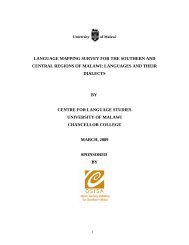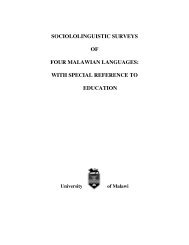languages and area spoken for chitipa - Centre for Language Studies
languages and area spoken for chitipa - Centre for Language Studies
languages and area spoken for chitipa - Centre for Language Studies
You also want an ePaper? Increase the reach of your titles
YUMPU automatically turns print PDFs into web optimized ePapers that Google loves.
The fact that the respondents acknowledged the similarities among the <strong>languages</strong> is what<br />
is clearly significant because it confirms the bservation that most of the language<br />
varieties encountered in the district are merely dialects despite their being called<br />
different <strong>languages</strong> by their speakers.<br />
When the researchers examined the varieties <strong>for</strong> featural similarities it was noted that<br />
even the linguistic features characterizing the variations showed predictable patterns, a<br />
phenomenon which makes it possible to group the dialects according to their linguistic<br />
similarities. Based on the linguistic evidence provided mainly by phonological <strong>and</strong><br />
lexical similarities, the researchers put the dialects into the following language groups (in<br />
a descending order of similarity):<br />
<strong>Language</strong> group 1: Cindali>Cisukwa>Cilambya<br />
<strong>Language</strong> group 2: Cinamwanga>Cimambwe>Ciw<strong>and</strong>ya<br />
<strong>Language</strong> group 3: Cinyiha/Cinyika<br />
<strong>Language</strong> group 4: Chichewa<br />
<strong>Language</strong> group 5: Citumbuka<br />
<strong>Language</strong> group 6. Cibemba<br />
<strong>Language</strong> group 7: Kiswahili<br />
The major phonological features that characterized the language groups with several<br />
dialects were mainly noticeable in the segmental features of certain sounds, the operation<br />
of certain phonological processes <strong>and</strong> tonal realizations. For instance, as it may be<br />
observed in the attached vocabulary list, post-nasal stops in Cindali <strong>and</strong> Cisukwa are<br />
voiced but they are not in the other related dialect, Cilambya, <strong>and</strong> even in the other<br />
distant dialects hence the word <strong>for</strong> ‘person’ is ‘umundu’ in Cindali <strong>and</strong> Cisukwa but<br />
‘umunthu’ in Cilambya <strong>and</strong> the other dialects. Likewise, grasshopper is ‘imbashi’ <strong>and</strong><br />
‘imbasi’ in Cindali <strong>and</strong> Cisukwa but ‘imphanzi’ in Cilambya <strong>and</strong> the other related<br />
dialects.<br />
On segmental features, the two most closely related dialects, Cisukwa, Cindali <strong>and</strong><br />
Cilambya differ because the first two do not have voiced fricatives while Cilambya does<br />
(see the words <strong>for</strong> ‘scorpion’, kalisya, kalisha <strong>and</strong> kalizga <strong>for</strong> the three varieties<br />
respectively <strong>and</strong> ‘maize’, ifilombe – <strong>for</strong> Cisukwa <strong>and</strong> Cindali- <strong>and</strong> ivilombe <strong>for</strong><br />
Cilambya).<br />
It is worth noting that although Kiswahili <strong>and</strong> Cibemba have listed above, these are not<br />
indigenous since they are mostly <strong>spoken</strong> by immigrants from neighbouring Tanzania <strong>and</strong><br />
Zambia respectively. It is also important to note that some of the language varieties given<br />
15





